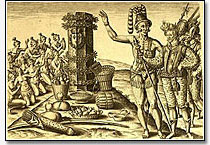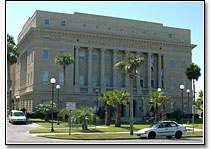Request Information
Your Name: Lake County Florida History
By 1763 when James Spalding established a trading post at Astor, there were few Indians left in the area. British Royal botanist, William Bartram came to the area to study the "flora and fauna." He made the first sighting of a royal palm tree in North America in Lake County in 1774. During the Revolutionary War all of Florida belonged to the British and residents were loyal to that country. A few white hunters and traders lived in Lake County, along with runaway slaves and Freedmen who found hiding in the scrub to be very effective means of evading the Slave Hunters. In 1782, Spain re-occupied Florida and began awarding large tracts of land to reward favors. In 1819 Moses Levy received such a land grant from the Spanish. He established a plantation along the St. Johns River in Lake County, which was to be a settlement for oppressed European Jews. He was the father of David Levy, who later changed his name to "Yulee." Mr. Yulee was Florida's first senator after it acquired its statehood.
During the first Seminole Indian War, the Seminole Indians burned the plantation to the ground. Forts were built throughout the county, known then as Mosquito County, to defend the settlers against the Seminole Indians. In 1823, at the Treaty of Moultie Creek, the Seminoles were ordered to live in a reservation, most of which was in Lake County. At the close of the Seminole War in 1842, Congress passed the Armed Occupation Act. It offered 160 acres to any man who would bear arms to protect the area against potential renewed hostilities, if he would build a habitable dwelling, live on the property for five years and cultivate at least five acres of his homestead. Many men accepted the challenge and joined the blacks already engaged in farming here. Towns grew and vanished. Other towns took their places.
When the Civil War started in 1861, there were several large plantations and many small farms in Lake County. Florida became one of the states to secede from the Union. The Statute of April 1862 forced most white males between the ages of 18 and 35 into involuntary service to the Confederacy. By September of that year the age limit was increased to 45 and soon 17-year-old young men were conscripted. This left only women and their slaves to run the plantations and farms. Even at that, Lake County has able to provide beef and other provisions to the army. The people left at home simply "went without." By the end of the Civil War in 1865, another homesteading act was in place, again offering 160 acres of land to settlers who would live on the land for five years and improve it. Soldiers, both Rebel and Yankee were eager to get on with their lives. The attractive Homesteading Act offered a fresh start and many men took advantage of the opportunity and came to Lake County to make their homes.
In July 1887, Lake County became a county. It was carved from Orange and Sumter counties. The courthouse, known as the Pioneer Building was dedicated in 1889. Contracts were let for the construction of the first hard surface roads in Lake County in 1915. Prior to that most transportation was on the waterways with special hybrid steam/paddlewheel boats, an elaborate system of railroads was also developed. A militia group was established during the Spanish-American War. It was called the 'Leesburg Rifles" and were ready to bravely defend our country. Many young Lake County men enlisted in the Armed Services of this and other countries during the First World War. Others stayed at home and served in the Home Guard. World War II took many Lake County men to war. Again, a Home Guard was established which combed the evening skies for enemy planes. The civilian effort was strong in support of the war. Lake County was famous for the number of war bonds sold here and scrap metal collected. In fact, the first war bond sold in the United States was sold in Leesburg. Lake County was the site of a Prisoner of War camp during the Second World War, as well.
Early industry consisted of reliance on the land: farming, citrus growing, lumber, turpentine, etc. All of this to some degree or another relied on the weather and time and time again big freezes killed not only crops and citrus, but also hopes and dreams. Back-to-back freezes in 1894 and 1895 devastated large and small farms alike. Some farmers replanted and others settled here, making their living at farming. Lake County was known worldwide for its record crops of peaches, tomatoes, watermelon, ferns, and, of course, citrus.
Other industries moved into Lake County and the economy grew. Lake County's history is rich and diverse. It sparkles with the ingenuity of its' people. Colorful stories abound. Today, as in the past, Lake County is a pleasant place to live and work.
Historic and Interesting facts:
Lake County became a legal entity on July 27, 1887 when it was created out of portions of Orange and Sumter counties. It was named Lake County because there were over 1400 lakes within its proposed boundaries. Tavares became the county seat after 3 elections that included political maneuvering and outright corruption.
|

 Lake County is some of the oldest inhabited land in Florida. Thousands of years ago the mild weather, excellent growing conditions, and abundance of fish and game, drew the Timucuan Indians to call this region their home. Evidence of their presence is throughout Lake County. In fact, there are more than 1000 identified archeological sites in Lake County. In 1562 a French Huguenot colony was established at the present site of Astor on the St. Johns River. The entire colony was wiped out by the Spanish is 1566. During the late 1560's
the Spanish established a system of missions throughout the Lake County area with the goal of converting the Indians to Catholicism. What they accomplished instead was to massacre uncooperative villages and spread
European diseases to the rest.
Lake County is some of the oldest inhabited land in Florida. Thousands of years ago the mild weather, excellent growing conditions, and abundance of fish and game, drew the Timucuan Indians to call this region their home. Evidence of their presence is throughout Lake County. In fact, there are more than 1000 identified archeological sites in Lake County. In 1562 a French Huguenot colony was established at the present site of Astor on the St. Johns River. The entire colony was wiped out by the Spanish is 1566. During the late 1560's
the Spanish established a system of missions throughout the Lake County area with the goal of converting the Indians to Catholicism. What they accomplished instead was to massacre uncooperative villages and spread
European diseases to the rest.  As part of his effort to have Tavares named as County Seat, Major St. Clair Abrams, who founded Tavares, borrowed $10,000 and built a courthouse, which later was known as the Pioneer Building. In 1922 the county floated a $250,000 Bond Issue and built a new courthouse which is now known as the Historic Courthouse.
The first Post Office was established in Okahumpka in 1845 when Florida was still a territory. In 1890, the first census
was formed and there were 8,034 people in the county. Agriculture was the main industry until the freezes of 1983, 1985 and
1989. Walt Disney's parents were married in a small town named Kismet, which no longer exists, on December 27, 1887.
As a child, Walt used to spend vacations visiting his Aunt Jessie Perkins in Paisley.
As part of his effort to have Tavares named as County Seat, Major St. Clair Abrams, who founded Tavares, borrowed $10,000 and built a courthouse, which later was known as the Pioneer Building. In 1922 the county floated a $250,000 Bond Issue and built a new courthouse which is now known as the Historic Courthouse.
The first Post Office was established in Okahumpka in 1845 when Florida was still a territory. In 1890, the first census
was formed and there were 8,034 people in the county. Agriculture was the main industry until the freezes of 1983, 1985 and
1989. Walt Disney's parents were married in a small town named Kismet, which no longer exists, on December 27, 1887.
As a child, Walt used to spend vacations visiting his Aunt Jessie Perkins in Paisley.